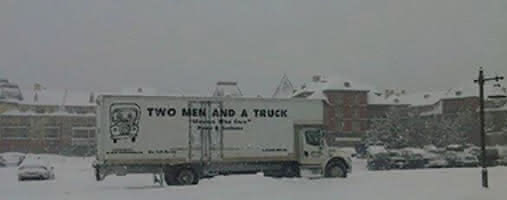
Moving when ice and snow are in the daily forecast isn’t a popular choice for many Canadians. It’s cold and slippery; but with some extra safety precautions, winter moving also has many advantages.
Moving last minute is not a problem if it’s during the winter months. When you move in the “off season” – sometime between November and March – you can save time and money. In comparison, summer is the busiest season for moving companies. During the summer months you must be well prepared, booking 6 to 8 weeks in advance to ensure your preferred moving company is available. Not only are movers in higher in demand but generally their rates are higher.
Some moving companies may be more willing to negotiate their rates during the winter months as they’re competing for business during the slow season. Likewise, less rush and stress for companies in the winter means you get their best employees resulting in a higher quality of service.
Blizzards, Black Ice and Moving
With everything booked, it’s time to start packing. Follow these tips for a relaxed and toasty move – no matter what’s going on outside those frosted windows.
- Have a contingency plan. Keep up to date with local weather forecasts and change your plans accordingly. If a big snowfall or freezing rain is expected the morning of your move day, don’t risk it.
- Keep cozy. Carry extra warm clothes for you and your family – including hats, gloves and snow pants. Pack these ahead of time and clearly label them so you can locate them immediately.
- Remember your items will be in a non-heated environment for a while. Ensure your plants, electronics and liquids are properly packed and protected from the cold.
- Allow extra time on the move day – cold weather slows things down. Additionally, rushing in the winter can lead to accidents and injuries.
- Make sure that the entrance to the moving room of your condo building, if you have one, is cleared of ice and snow. Slipping can not only lead to dropped boxes and broken possessions, but also personal injury.
- Quality movers will use floor runners to protect your floors in high traffic area but for extra protection inside, cover your floors to protect them from tracked-in snow, mud, and salt.
- Drive safe. Make sure maintenance and service on your vehicles is current. Check the air pressure on your tires and ensure the trunk is equipped with emergency kits (matches, flashlight, food), blankets, and shovels. Drive slowly with extra caution.
- Be certain that your heating company for your new home is aware of your move in day.
Wintertime moving doesn’t have to be wet and miserable. With these reminders, you’ll be packed up, moved and basking in the warmth of your new home before you know it.
Marshall Taylor says
This is excellent advise. Being a mover myself for a couple years, these are key tips to having a quicker, safer, and relatively cheaper move
TwoMenCanada says
Thanks Marshall! Stay safe (and warm) out there!